Porsche’s first all-electric car, the Taycan, comes in many guises, Taycan 4S and Taycan turbo being some of them. On test with us is arguably the most fun version. Just called the Taycan, with no prefix or suffix, it features a single 326hp motor that drives only the rear wheels. You get a maximum of 408hp in ‘overboost’ when you use launch control.
Porsche Taycan: exterior and design
In the flesh, the Taycan features voluptuous haunches, a coke bottle waist, a 911-like tight-fitting cabin and loads of shapes and forms you can’t quite perceive in flat two dimensions or in pictures.
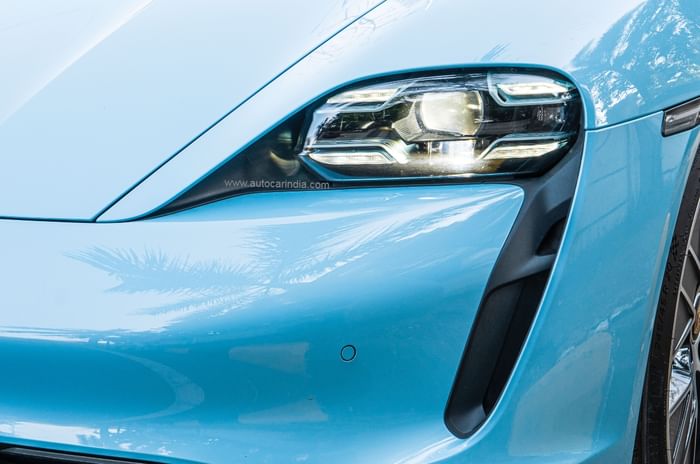
Unique headlight design makes the Taycan stand out.
There’s also loads of Porsche DNA here. The low, sloping bonnet, the fat-bottomed 911 rear, the squat stance. Thereis more Porsche here than on a Panamera. I even love the ‘spooky’ stingray-eye-like headlights and shark-gill-like ‘vents’ behind the wheel arches.
What also gets the attention of onlookers is the low slung profile, and then, from the rear, the single slash like red LED is pure 911. In addition, the Porsche badge placed inside the glass ‘window’ looks cool, especially when sunlight hits it, and the mini fins behind the charging ports also work superbly. Press them and the flap moves up automatically.

Ride is excellent despite the 45 and 40 profile tyres.
The Taycan is also the most aerodynamic Porsche yet. It has a drag coefficient of 0.22 and uses big air curtains around the wheels (with intakes below the headlights) and a flat floor to accelerate air flow and increase downforce. There is a pop-up spoiler at the rear, needed to disrupt the airflow and prevent lift as speeds rise, and the front bumper has cooling flaps that open and close.

Porsche Taycan: interior
As you step into the driver’s seat,the doors thud home with precision; nice for frameless doors. Then, what impresses, is the solid dash, the perfectly built steering wheel and the typical Porsche layout. What you can’t help but be blown away by, however, are the number of screens. It’s like a ‘glass’ cockpit of an aircraft in here.
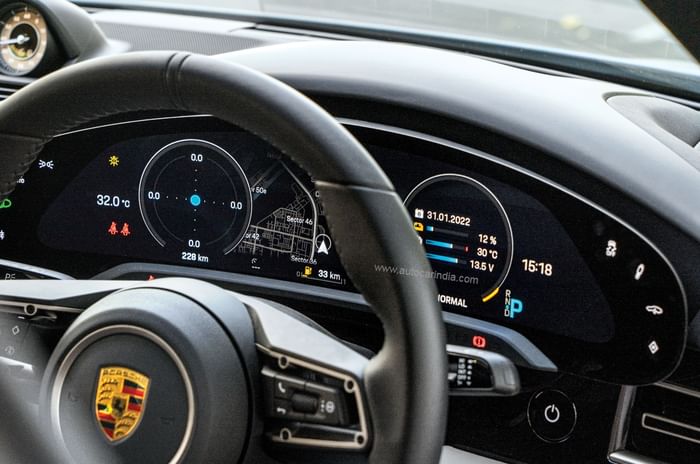
A beautiful 16.8-inch piece of frameless curved glass works as the instrument cluster. While there’s no hood to shield it from the sun, the amazing bit is that visibility is always good. You can customise the display from the steering wheel, of course, but it uniquely also works as a touchscreen around the edges. The ‘buttons’ include stuff like the dampers and ESP settings on the right, with headlights and others placed on the left. The screen is sharp, clear and there’s plenty of information. Still, not having a big central tachometer feels odd on a Porsche and I would have liked the option of a traditional speedometer in one of the modes.
To the instrument panel’s left is the central touch screen that measures 10.8 inches. While the resolution is very good, the screen occasionally needs a second push to engage a ‘button’. And while the design is neat, you have to search for essential functions, at times, as some are buried deep inside sub-menus.
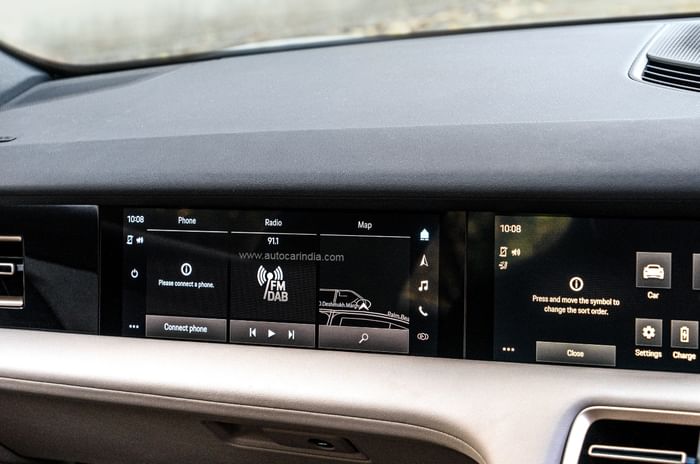
The 8.4-inch screen, placed lower down on the central console, is for climate control and other functions. Resolution isn’t as good here and it isn’t very functional; adjusting stuff like fan speed is fiddly. The Taycan also has vents that you can only adjust from the touchscreen. While this is cool to play with, you cannot adjust the vents manually with your fingers, which makes adjusting airflow on the move almost impossible.
Onto screen number four. You can also option a wide touchscreen that sits on the dash ahead of the front passenger. This makes the dash look like it is made up of one long, continuous screen. Since the screen serves no functional purpose, this is at best a cosmetic feature.
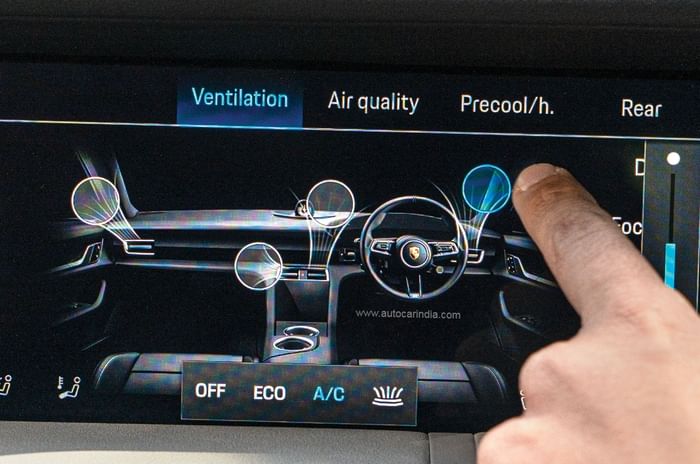
Love the driving position though. The seating position is low and sporty, but not too low, visibility is excellent and the angle of the steering column is perfect; you can bring the steering in or take it out and still be comfortable.
Legroom in the rear is also very good due to the long wheelbase. And visibility from the rear is decent as well, despite the front headrests blocking your view on either side. The seat is low, however, so you sit a bit knees up and there’s space for only two passengers at the rear. A rubberised tray for odds and ends is placed between the seats. A tight fitting roof also means headroom for those above six feet could be at a premium.
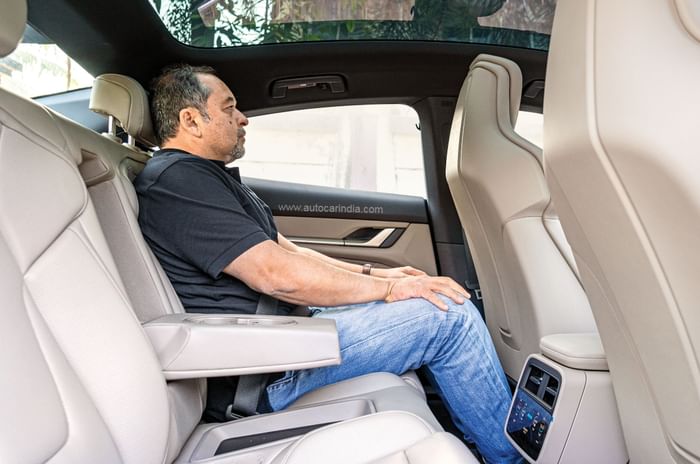
Sporty seats are supportive, but you are sat a bit low.
The massive glass roof, however, brightens up the cabin, and sitting in the back with all the diffused sunlight flooding in and the blue sky above does feel special. The polarised glass roof though, is likely to transmit some amount of heat during summer, and the USB C ports are hidden out of view. They are placed below the cushioning in between the left and right seat, which makes them very difficult to access or even see.
Other kit on this car includes wireless charging and cooled seats, a rumbling whine-like Porsche Electric Sport Sound that isn’t too bad, Sport Chrono Package, LED Matrix main headlights, Porsche Dynamic Lighting System, Head-Up Display and Park Assist Surround View.
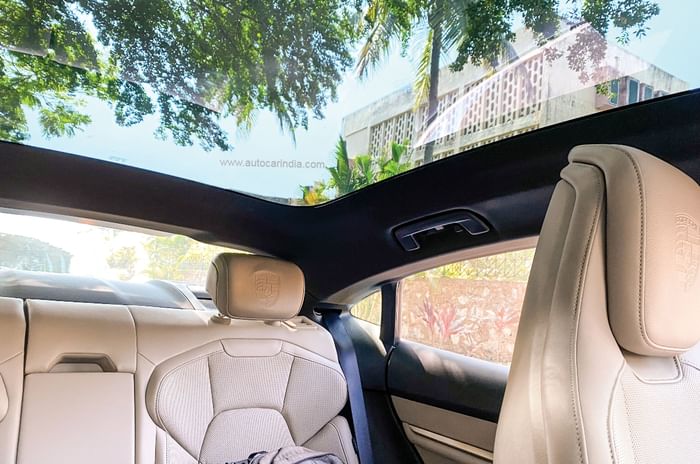
Porsche Taycan: e-motor, battery and charging
The Taycan’s326hp permanent magnet synchronous motor has a rotor diameter of 245mm and a length of 130mm. It runs with a 600A pulse inverter and uses a 2-speed gearbox for strong acceleration and efficient highway cruising. The Performance Battery has a gross capacity of 79.2kWh and can charge at up to 225kW.
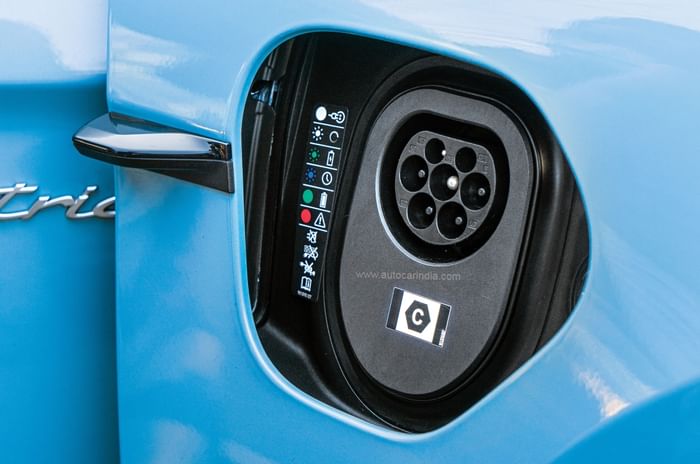
The larger optional Performance Battery Plus weighs approximately 77kg more, features a gross capacity of 93.4kWh and can charge at up to 270kW. With the Performance Battery Plus, the motor can produce up to 469hp. When it comes to charging, a 11kW AC current charger will charge the car from 0-100 percent in eight hours. A 50kW DC charger can take the battery from 5 percent to 80 percent in one-and-a-half hours.
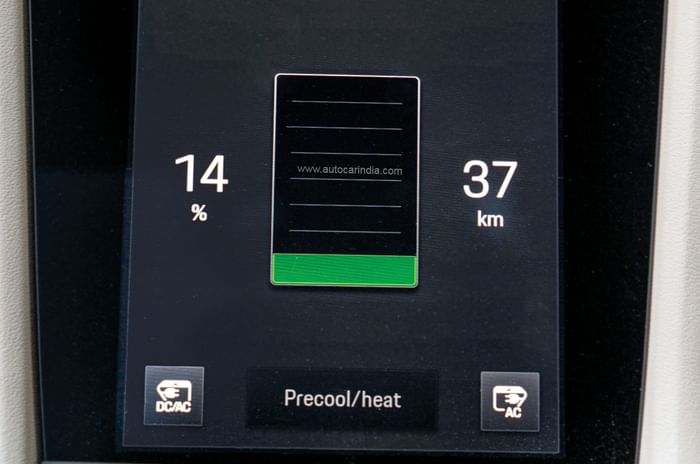
Porsche Taycan: performance
If it just says Taycan at the rear, it means the car comes with one electric motor driving the rear wheels; arguably the right spec to have. The Taycan here comes with the standard 79.2kWh Performance Battery. The battery can be upgraded to a larger 93.4kWh unit, but that weighs 77kg more.
As I select Drive via the high-quality, dash-mounted lever and tap the accelerator pedal, throttle responses feel well measured. There’s enough thrust supplied to get the Taycan moving smartly. As I move from Normal to Sport, responses are faster. This suits my driving style a bit more, so I stick to it. And here too, as I use more and more right pedal, but reactions aren’t over the top. This linear ramp up in performance means I don’t need to pay undue attention to driving smoothly, and even then,though I’m using automatic regeneration, there doesn’t seem to be any unnatural drag. In Sport, however, it is easier to tell when the 2-speed transmission shifts, especially when you take off from the lights. In fact overall driving manners are so ‘normal’ and combustion engine-like, it comes as a pleasant surprise.
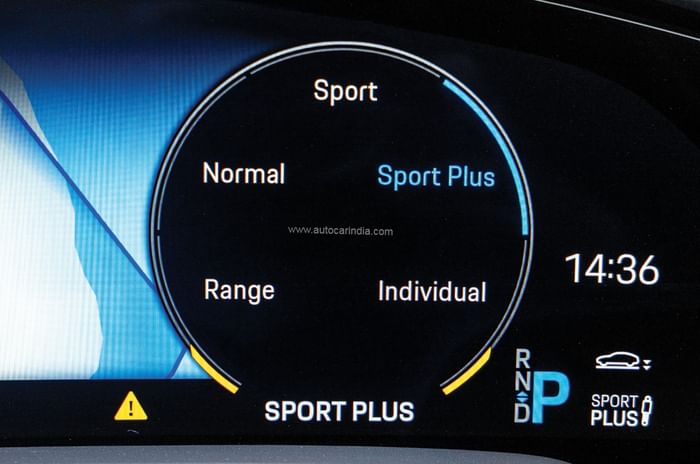
Sport Plus isn’t too hard-edged, even on our roads.
Using launch control even reels in the horizon and performance feels much stronger here with the ‘overboost’. 0-100kph takes a claimed 5.4sec, and it will do 200 in around 17.6sec. This is sufficient to keep the drive fun and interesting, and there’s plenty of power when you want to drive on some winding roads too.
That kick you get in the back from a fast electric, however, just isn’t there. With just 326hp on tap (with the overboost used for only launch control) and a 2-tonne kerb weight, there’s no neck-snapping acceleration. You aren’t hurled back in your seat, like you are in a fast Tesla or even Porsche’s own Taycan Turbo, and then, Audi’s e-tron GT, also on sale here, is much, much quicker too.
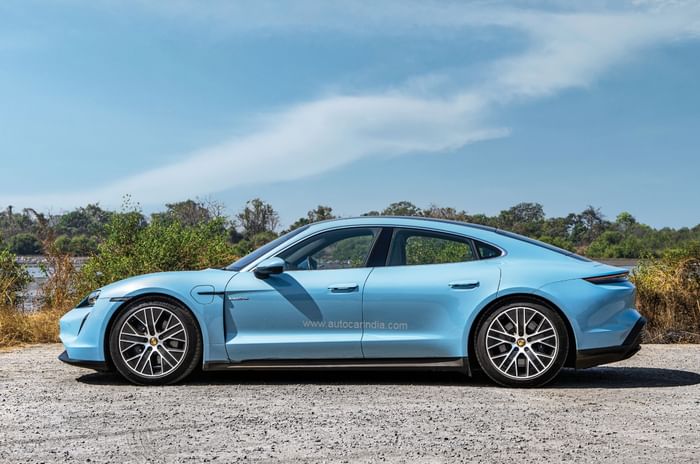
Porsche Taycan: driving dynamics
Where the rear-wheel-drive Taycanshines, however, is in the driving dynamics department. Despite having to lug half a tonne of battery under its belly, it delivers a near-perfect score. Call it years of experience, the innate ability of its engineers to neutralise the negative effects of poorly distributed weight (see rear-engined 911 and 2-tonne Cayenne), or just Porsche magic, the Taycan clearly has it.
For one, the ride is shockingly good. It isn’t light-footed in the manner in which it covers ground and it has a heft to it as it goes down the road, but bump absorption is so good, and the chassis rides so flat, it feels almost as good as a limo. Ride isn’t pillowy and it won’t float over like a typically softly-sprung American car, but it absorbs such a high percentage of the knocks the road throws at it, only a few thuds filter in. Even then,on our bad roads, there’s no pitch or waddle. The super-stiff chassis, with the battery working as a load-bearing chassis component, and the new-generation air suspension and adaptive dampers surely play a role here.
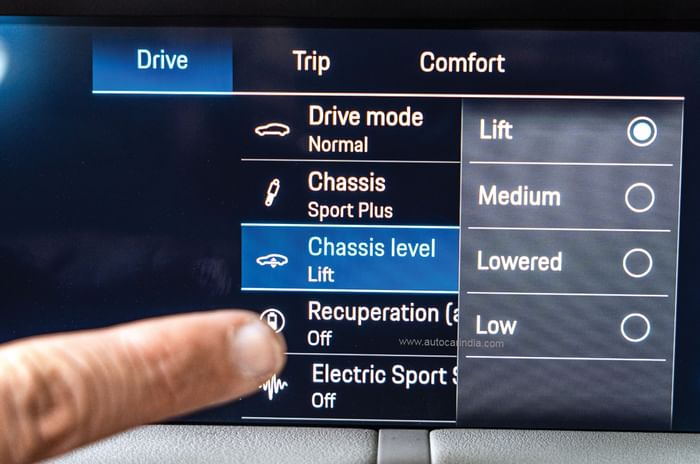
You have to be careful over large speed breakers though. With the suspension in ‘mid’ setting, most speed breakers can be driven over if you are careful. You do need to engage the lift function when you come upon larger ones. Fail to do this, or don’t wait till the air springs lift the car fully, and the car will scrape its belly.
Where the Taycan completely nails it is when it comes to corners. It isn’t exactly lithe or light on its feet, and the brakes need to have better feel, but that apart, this is currently the best driving mainstream EV in the world. And that too by a country mile.
The steering, to begin with, has loads of feel. It weighs up as you go faster– which is good– there’s zero slack as you turn in, and steering weight stays consistent even when you hurry it up.
There’s only some small amount of roll as you turn in, but grip from the front wheels is very reassuring, the car responds to steering inputs very faithfully, and then, what feels great is the reassuring push from the rear axle as you accelerate out.
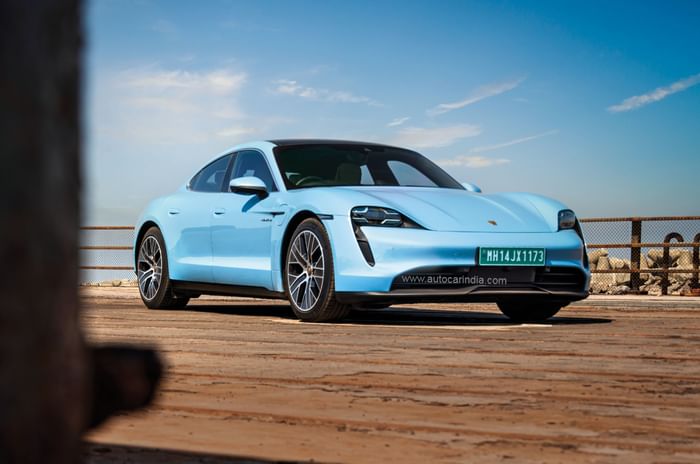
The best bit, however, is that the Taycan, unlike any EV before it, feels more playful the harder you drive it, seemingly encouraging you to carry more speedand accelerate out earlier or try a different line. It seems like a cliche, but the Taycan drives like a real Porsche, one you want to drive over a winding road; again and again and again. And that’s just huge.
While Tesla may have shown the world that EVs can deliver heady performance, it’s Porsche’s Taycan, especially this rear-wheel-drive one, that has proven they can be seriously fun to drive too: real enthusiast-focused cars that put a smile on your face. Hats off to Porsche’s engineering department for that.
Porsche Taycan: verdict
Porsche’s Taycan is a game changer. An electric car you can genuinely enjoy from behind the wheel, almost as much as any combustion engine-powered car, it represents a big step forward in the evolution of the electric car. It rides very comfortably over our roads, can handle large speed breakers and unbuilt sections of road, and the cabin is very comfortable and well appointed.
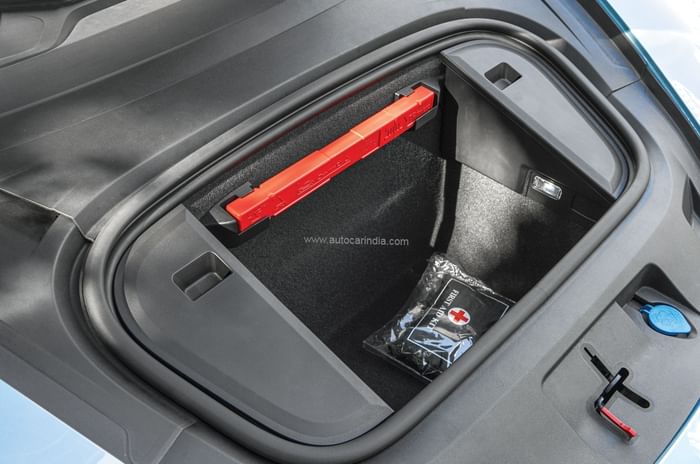
The sporty seating position in the rear means that comfort in the back isn’t limo-like, the Taycan is down on straight-line performance compared to rivals, and at Rs 1.5 crore for a base car (and roughly Rs 30 lakh more for a car in this spec), it is expensive, especially for the performance you get. The Audi RS e-tron GT, for example, gets 646hp and costs Rs 2.05 crore. Still, if you want to go electric and want the best driving car around– one that works well in our conditions– the Taycan is for you.








































